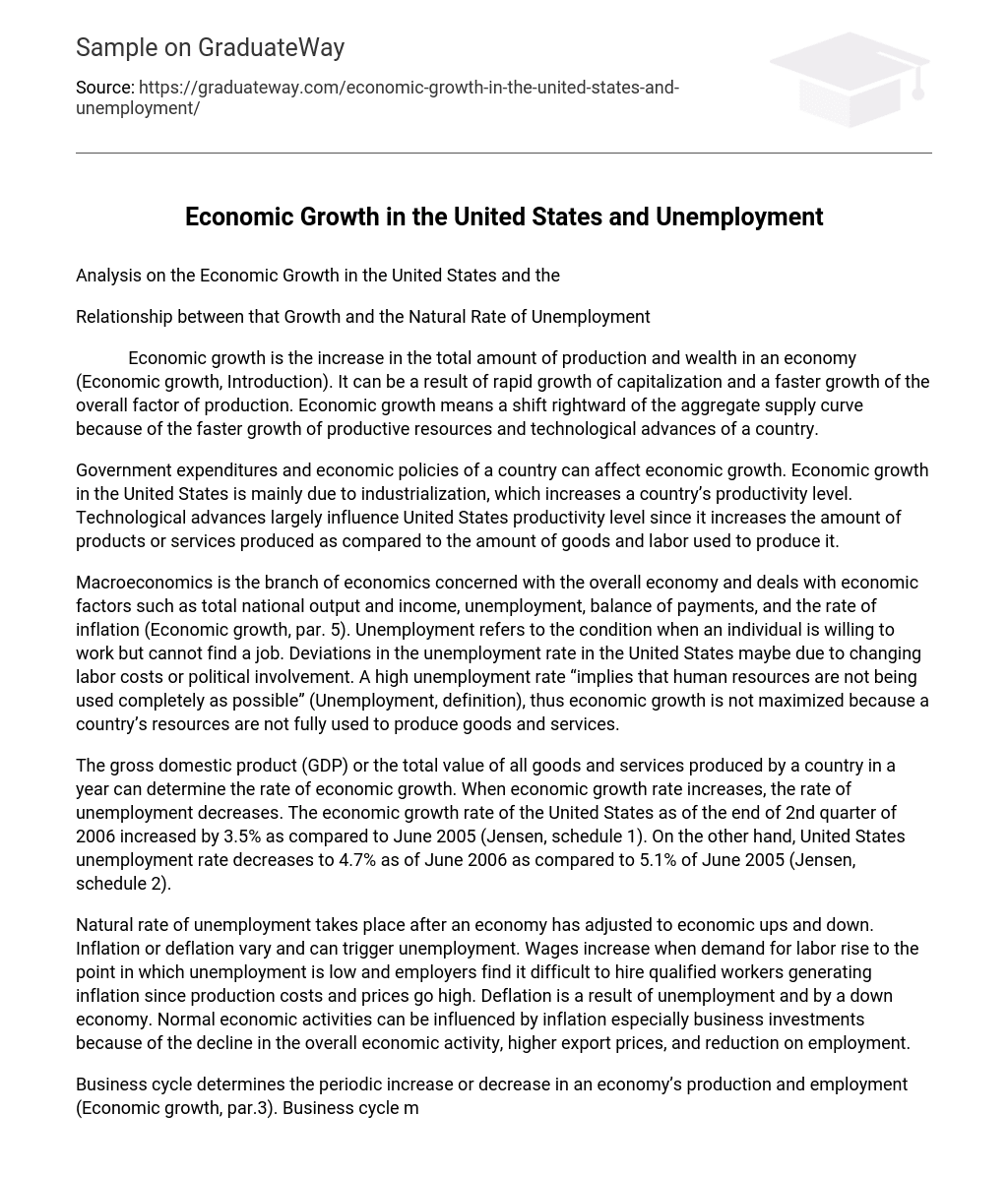Analysis on the Economic Growth in the United States and the
Relationship between that Growth and the Natural Rate of Unemployment
Economic growth is the increase in the total amount of production and wealth in an economy (Economic growth, Introduction). It can be a result of rapid growth of capitalization and a faster growth of the overall factor of production. Economic growth means a shift rightward of the aggregate supply curve because of the faster growth of productive resources and technological advances of a country.
Government expenditures and economic policies of a country can affect economic growth. Economic growth in the United States is mainly due to industrialization, which increases a country’s productivity level. Technological advances largely influence United States productivity level since it increases the amount of products or services produced as compared to the amount of goods and labor used to produce it.
Macroeconomics is the branch of economics concerned with the overall economy and deals with economic factors such as total national output and income, unemployment, balance of payments, and the rate of inflation (Economic growth, par. 5). Unemployment refers to the condition when an individual is willing to work but cannot find a job. Deviations in the unemployment rate in the United States maybe due to changing labor costs or political involvement. A high unemployment rate “implies that human resources are not being used completely as possible” (Unemployment, definition), thus economic growth is not maximized because a country’s resources are not fully used to produce goods and services.
The gross domestic product (GDP) or the total value of all goods and services produced by a country in a year can determine the rate of economic growth. When economic growth rate increases, the rate of unemployment decreases. The economic growth rate of the United States as of the end of 2nd quarter of 2006 increased by 3.5% as compared to June 2005 (Jensen, schedule 1). On the other hand, United States unemployment rate decreases to 4.7% as of June 2006 as compared to 5.1% of June 2005 (Jensen, schedule 2).
Natural rate of unemployment takes place after an economy has adjusted to economic ups and down. Inflation or deflation vary and can trigger unemployment. Wages increase when demand for labor rise to the point in which unemployment is low and employers find it difficult to hire qualified workers generating inflation since production costs and prices go high. Deflation is a result of unemployment and by a down economy. Normal economic activities can be influenced by inflation especially business investments because of the decline in the overall economic activity, higher export prices, and reduction on employment.
Business cycle determines the periodic increase or decrease in an economy’s production and employment (Economic growth, par.3). Business cycle may affect unemployment rate. The causes of unemployment can be frictional, seasonal, structural, or cyclical. Politics can also affect business cycle. Frictional unemployment takes place when there are workers seeking jobs but do not find one right away, which increases the rate of unemployment. The gap between the time of looking for a new job affects the unemployment rate of a country but only for a short time. In the United States, the rate of turnover is high, thus frictional unemployment is always present. Low unemployment rates give workers greater bargaining power.
Unemployment can also be structural which arises when there is a lack of qualified individuals employers are looking for a specific job. In the United States, certain industries are looking for new skills brought about by new technological advances, and for those employees who are highly qualified and trained to do a specific job.
Bibliography
“Economic Growth”. Encarta Reference Library 2004. 14 December 2006.
Jensen, Arthur. Economic Forecast for the United States. 2006 July. 13 December 2006 <Http://www.csus.edu/indiv/j/jensena/sfp/us/>
“Unemployment”. Wikipedia: The Free Encyclopedia. 9 December 2006. 14 December 2006
<Http://en.wikipedia.org/wiki/Unemployment>





